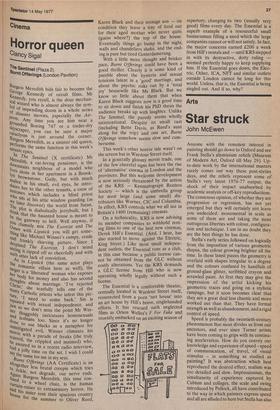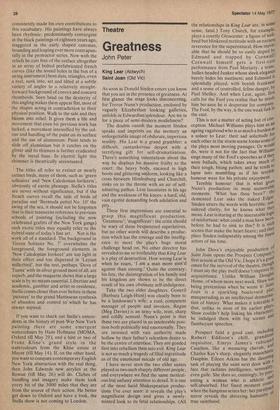Arts
Star struck
John McEwen
Anyone with the remotest interest in painting should go down to Oxford and see Frank Stella's aluminium reliefs (Museum of Modern Art, Oxford till May 29). Up-. to-date work by the international masters rarely comes our way these post-sixties days, and the reliefs represent some of Stella's very latest 1976-77 output, the shock of their impact unabsorbed by academic analysis or off-key reproductions. The consensus opinion, of whether they are progression or regression, has not yet emerged but they will certainly not leave you undecided: monumental in scale as some of them are and taking the most outrageous liberties with colour, configuration and technique. I am in no doubt they are the best things he has done.
Stella's early series followed on logically from the imposition of various geometric shapes, the colour growing brighter all the time. In these latest pieces the geometry is overlaid with shapes irregular to a degree and the colours confused by handfuls of ground-glass glitter, scribbled crayon and scrawled paint. At first they may give the impression of the artist kicking his geometric traces and going on a stylistic rampage, but it soon becomes clear that they are a great deal less chaotic and more worked out than that. They have formal strength as well as abandonment, and a rigid control of Speed.
Speed is probably the twentieth-century phenomenon that most divides us from our ancestors, and ever since Turner artists have been coming to grips with its continuing acceleration. How do you convey our knowledge and experience of speed –speed of communication, of travel, of visual stimulus – in something as studied as painting? It was abstraction which best reproduced the desired effect, realism was too detailed and slow. Impressionism, the simultaneity of experience captured by Cubism and collages, the scale and swing introduced by Pollock, all have contributed to the way in which painters express speed and all are alluded to here but Stella has also
consistently made his own contributions to this vocabulary. His paintings have always been rhythmic: predominantly convergent in the black paintings of eighteen years ago, staggered in the .early shaped canvases, bounding and leaping ever more contrapuntally in the protractor series. Now with the reliefs he cuts free of the surface altogether in an array of bolted prefabricated french curves (like the sound holes in the box of a string instrument) bent slats, triangles, even a reel, sunk into, set and tilted at a subtle variety of angles to a relatively straightforward background of convex and concave rhomboids. Seen head on the dexterity of this angling makes them appear flat, most of the shapes acting in contradiction to their physical position. Walk to the side and they bloom into relief. It gives them a life and movement that even his previous work has lacked, a movement intensified by the colour and handling of the paint on its surface and the use of aluminium. Paint tends to slide off ,aluminium but it catches on the glitter and its thinness is further eradicated by the metal base. In electric light this shimmer is theatrically accentuated.
The titles all refer to extinct or nearly extinct birds, many of them, such as 'green solitaires' and 'New Caledonian lorikeets', obviously of exotic plumage. Stella's titles are never without significance, but if the french curves recall the tails of birds of paradise and 'Bermuda petrel No. 10' the swing of the sea, it should not be forgotten that in their mannerist reference to previous schools of painting (including the now celebrated grafitti of the New York gangs) such exotic titles may equally refer to the hybrid state of today's fine art. Nor is the work all of ,a standard. The background in 'Green Solitaire No. 7' overwhelms the foreground, the foreground elements in 'New Caledopian lorikeet' are too light in their effect and too dispersed in `Laysan millerbird', but the rest, perhaps 'Dove of Tanna' with its silver ground most of all, are superb, and the maquette shows that a large scale is by no means essential. Libertine and academic, gambler and artist-in-residence, Stella comes closer than ever before in these 'pictures' to the grand Mattissean synthesis of abandon and control to which he has always aspired.
If you want to check out Stella's antecedents in the history of post-War New York painting there are some .emergent watercolours by Hans Hofmann (MOMA, Oxford till May 29), and a hint or two of Franz Kline's grand style in the watercolours from the Kline estate at Mayor (till May 14). If, on the other hand, you want to compare contemporary English New York abstraction with the real thing, then John Edwards new acrylics at the Rowan (WI May 26) will do. Cliches of handling and imagery make them look every bit of the 3000 miles that they are from the source of their action. He better get down to Oxford and have a look, the Stella show is not coming to London.



































 Previous page
Previous page